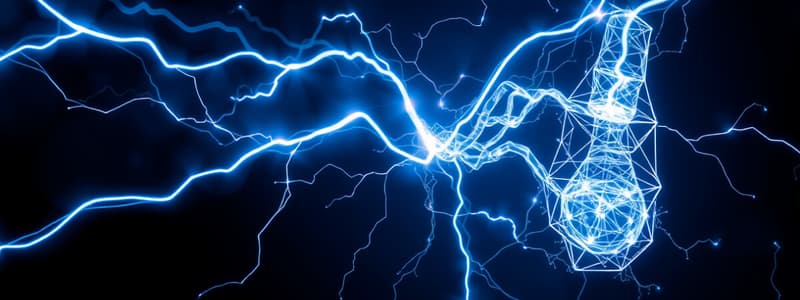Podcast
Questions and Answers
What is required for electric current to flow through a circuit?
What is required for electric current to flow through a circuit?
- A complete, unbroken path from the power source through the circuit and back (correct)
- An incomplete path from the power source
- Direct contact between the circuit components
- Multiple voltage sources connected together
What controls the flow of current in a simple circuit?
What controls the flow of current in a simple circuit?
- A switch (correct)
- A capacitor
- A resistor
- A diode
What happens when the switch in a simple circuit is open?
What happens when the switch in a simple circuit is open?
- The circuit is broken, and the current stops flowing (correct)
- Voltage increases significantly
- The energy source is disconnected
- Current flows continuously
What is transferred as electric current travels through a circuit?
What is transferred as electric current travels through a circuit?
Which symbol represents a battery in a circuit diagram?
Which symbol represents a battery in a circuit diagram?
In which direction does current flow in a circuit?
In which direction does current flow in a circuit?
What is the unit of measurement for electric current?
What is the unit of measurement for electric current?
What instrument is used to measure voltage?
What instrument is used to measure voltage?
What is the process called by which electricity generators convert energy from various sources into electrical power?
What is the process called by which electricity generators convert energy from various sources into electrical power?
Which component of the electricity grid lowers the voltage for safe distribution?
Which component of the electricity grid lowers the voltage for safe distribution?
Flashcards are hidden until you start studying
Study Notes
Electric Current Flow
- A complete and unbroken path is essential for electric current to flow in a circuit.
- Current requires a defined loop from the power source through various components and back.
Circuit Control
- The flow of current in a simple circuit is regulated by a switch, which can open or close the circuit.
Open Switch Behavior
- When the switch is open, the circuit becomes broken, halting the flow of current.
Energy Transfer
- Energy is transmitted from the power source to circuit components like lamps and motors as electric current travels.
Battery Symbol
- In circuit diagrams, a battery is depicted with long and short parallel lines, indicating its terminals.
Direction of Current Flow
- Current flows from the positive terminal to the negative terminal of the power source, establishing a direction of flow.
Measurement of Electric Current
- The ampere (A) serves as the unit of measurement for electric current, quantifying its strength.
Voltage Measurement
- A voltmeter is the instrument used to measure electrical voltage within a circuit.
Energy Conversion Process
- Electricity generators convert energy from diverse sources into electrical power through a process known as electromagnetic induction.
Renewable Energy Sources
- Common renewable energy sources for electricity generation include wind, solar, and hydropower.
Voltage Reduction in Electricity Grid
- Substations are responsible for lowering high voltage levels for safe distribution within the electricity grid.
High-Voltage Electricity Transmission
- High-voltage electricity is transmitted over long distances during the transmission stage of electricity distribution.
Applications of Electricity
- Electricity is commonly used for powering residential and commercial buildings, running machinery, charging electric vehicles, and supporting communication systems.
Studying That Suits You
Use AI to generate personalized quizzes and flashcards to suit your learning preferences.




